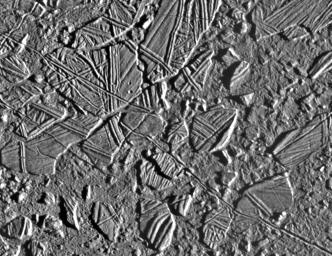
|
Europa Ice Rafts
- Click the image above for a larger view
- Full-Res JPEG (1710 x 1320) (342.0 kB)
- Full-Res TIFF (1710 x 1320) (2.5 MB)
Caption:
This high resolution image shows the ice-rich crust of Europa, one of the moons of Jupiter. Seen here are crustal plates ranging up to 13 kilometers (8 miles) across, which have been broken apart and "rafted" into new positions, superficially resembling the disruption of pack-ice on polar seas during spring thaws on Earth. The size and geometry of these features suggest that motion was enabled by ice-crusted water or soft ice close to the surface at the time of disruption.
The area shown is about 34 kilometers by 42 kilometers (21 miles by 26 miles), centered at 9.4 degrees north latitude, 274 degrees west longitude, and the resolution is 54 meters (59 yards). This picture was taken by the Solid State Imaging system on board the Galileo spacecraft on February 20, 1997, from a distance of 5,340 kilometers (3,320 miles) during the spacecraft's close flyby of Europa.
Background Info:
The Jet Propulsion Laboratory, Pasadena, CA, manages the mission for NASA's Office of Space Science, Washington D.C. This image and other images and data received from Galileo are posted on the World Wide Web Galileo mission home page at: http://galileo.jpl.nasa.gov.
Cataloging Keywords:
| Name | Value | Additional Values |
|---|---|---|
| Target | Europa | Jupiter |
| System | Jupiter | |
| Target Type | Satellite | Planet |
| Mission | Galileo | |
| Instrument Host | Galileo Orbiter | |
| Host Type | Orbiter | |
| Instrument | Solid-State Imaging (SSI) | |
| Detector | ||
| Extra Keywords | Grayscale, Water | |
| Acquisition Date | ||
| Release Date | 1998-03-26 | |
| Date in Caption | 1997-02-20 | |
| Image Credit | NASA/JPL/ASU | |
| Source | photojournal.jpl.nasa.gov/catalog/PIA00591 | |
| Identifier | PIA00591 | |
